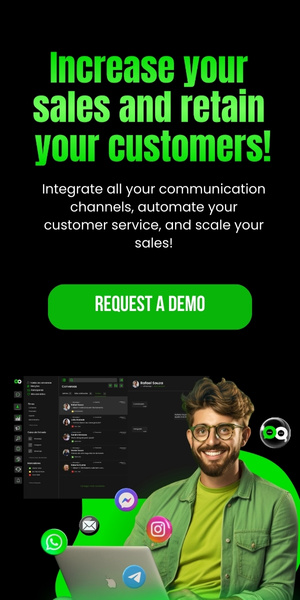Chatbots are transforming how businesses interact with their customers, offering quick responses, efficient automation, and 24/7 support.
With the popularization of technologies like Artificial Intelligence (AI), these tools have become prominent in customer service and sales strategies.
But what exactly is a chatbot, and how does it work? Let’s explore this technology and understand why it has become indispensable for companies looking to optimize their processes.
What is a Chatbot?
A chatbot is a computer program designed to simulate human conversations. It can be integrated into various communication channels, such as websites, messaging apps (WhatsApp, Messenger, Telegram), e-commerce platforms, and social networks.
The main function of a chatbot is to automate interactions, answer frequently asked questions, and, in some cases, perform more complex tasks such as processing orders or collecting information.
There are two main types of chatbots:
- Rule-based chatbots: Use predefined commands to answer specific questions. They are ideal for simple tasks, such as providing information about opening hours or prices.
- AI-powered chatbots: More sophisticated, they learn from previous interactions using techniques like Natural Language Processing (NLP). This allows for more personalized responses and a smoother experience.
How Does a Chatbot Work?
To understand how chatbots work, it’s essential to know the components that make up this technology. Here are the main aspects:
Natural Language Processing (NLP)
NLP is the technology that enables a chatbot to understand and process what the user is saying in natural language. Instead of only responding to exact commands, the chatbot interprets context, synonyms, and linguistic variations. For example:
- User query: “What’s the price of the premium plan?”
- The chatbot identifies the keyword “price” and the context “premium plan” to provide an accurate response.
Database
Chatbots use a database to store responses, product information, customer records, and other relevant data. When a question is asked, the chatbot searches the database for the most suitable answer.
Machine Learning
For AI-powered chatbots, machine learning is essential. They analyze previous interactions to improve their responses. Over time, these tools learn to handle complex questions and provide more accurate answers.
Integration with Other Systems
To maximize their potential, chatbots are integrated with platforms such as CRMs, ERPs, and support tools. This allows for:
- Collecting and organizing customer data;
- Automating internal processes;
- Sending mass messages for marketing campaigns.
Why Does Your Business Need a Chatbot?
Chatbots offer numerous advantages for businesses of all sizes. Here are the main benefits:
24/7 Support
Unlike human agents, chatbots are always available, ensuring customers receive responses even outside business hours. This reduces wait times and enhances the customer experience.
Cost Reduction
Automating repetitive tasks, such as answering FAQs or recording information, reduces the need for a large team. This allows your company to allocate resources to more strategic areas.
Increased Customer Satisfaction
Well-configured chatbots ensure quick and accurate responses, improving how customers perceive your brand. Additionally, personalized interactions create a more engaging experience.
Lead Generation
A chatbot can be programmed to collect valuable information from potential customers, such as names, emails, and interests. This simplifies the sales team’s job, enabling them to focus on the most qualified leads.
Scalability
Whether serving 10 or 1,000 customers simultaneously, a chatbot can handle the demand without overloading systems or affecting service quality.
Practical Use Cases
Companies across various industries are using chatbots to transform their operations. Here are a few examples:
- E-commerce: Chatbots help customers find products, check order status, and even make purchases, optimizing the sales funnel and increasing conversions.
- Customer Service: In customer support, chatbots handle common inquiries such as return policies, operating hours, and product information.
- Education: Educational institutions use chatbots to answer student questions, provide study materials, and schedule events.
- Marketing: With automation, chatbots send personalized messages, promotional notifications, and remarketing campaigns, increasing engagement.
Chatbots and Nexloo: A Strategic Partnership
In the pursuit of efficient customer service, Nexloo stands out as a comprehensive solution. Its omnichannel platform integrates various communication channels, enabling chatbots to serve customers on WhatsApp, Messenger, Instagram, and other platforms.
With Nexloo, your company can:
- Configure intelligent chatbots to automatically answer FAQs and collect customer data;
- Manage multiple channels in one place, ensuring unified service;
- Personalize interactions to create a unique experience for each customer;
- Analyze detailed reports to identify service patterns and improvement opportunities.
Additionally, Nexloo offers a 7-day free trial, allowing your company to experience the benefits of this solution risk-free.
How to Implement a Chatbot in Your Business
Implementing a chatbot may seem complex, but with the right tools, it’s a straightforward process. Here’s the step-by-step guide:
- Define Objectives
Determine what problems the chatbot should solve. Will it be used for customer service, sales, or marketing campaigns? - Choose the Platform
Opt for a robust solution like Nexloo, which offers integration with multiple channels and advanced automation features. - Create a Conversation Flow
Develop a script for the chatbot, mapping possible questions and answers. Remember to include personalized messages for a humanized experience. - Train the Chatbot
If AI-based, feed it with relevant data to help it learn and improve its responses. - Test and Optimize
Before launching, test the chatbot in various scenarios. After launching, monitor interactions and adjust the flow as needed.
Conclusion
Chatbots are a powerful tool revolutionizing customer service and optimizing business processes. By implementing this technology, your company not only enhances the customer experience but also achieves operational efficiency.
With Nexloo, you have access to a complete platform to configure and manage your chatbots easily and effectively. Try the 7-day free trial and discover how to transform your communication with customers!
Optimize your service today. Click here to learn more about Nexloo!




